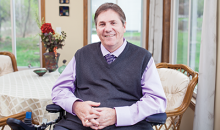As a rule, Physician Assistants (PA) are passionate about their profession. They aren’t simply practitioners, they are proponents, eager to extol the virtues of their chosen field. Alumni from GW’s School of Medicine and Health Sciences (SMHS) PA program, however, carry that passion a little further than most.

Take John Trimbath, PA ’79, past president of the Ohio Association of Physician Assistants (OAPA), as an example. For more than 30 years, Trimbath has championed the cause of PAs, both as a role-model clinician and through scores of leadership positions with the OAPA and the American Academy of Physician Assistants (AAPA). Why? Because of his solemn belief in the value of his profession and an unwavering commitment to its development — values he credits SMHS faculty mentors for imparting.
“I attribute a lot of my training, many of the things I’ve be able to accomplish, to the George Washington University,” says Trimbath. “The underpinning of the profession began in Washington, D.C., and the underpinning of my own personal growth and career started when I was a student at GW.”
Under the influence of the program’s inaugural Director and Assistant Dean for Health Sciences Jarrett M. Wise, PA, who would later serve two terms as the president of the Physician Assistant Foundation, and Karl R. Katterjohn, PA, GW’s PA program director when Trimbath was a student, he and his classmates would become activists for the profession. “They instilled in us the importance of not only developing excellent clinical skills, but also, because of how new the profession was, they made it clear that it was imperative for us to get involved and campaign for our profession.”
At that time, less than five years after the founding of GW’s PA program, Trimbath recalls there weren’t many PAs in practice. “The only way the profession could develop into what it has become today was for us to be advocates,” he says.
Growth Potential
By 1980, just a year after Trimbath entered practice in Euclid, Ohio, PAs had worked to gain prescriptive authority in 10 states across the country. It would be another 28 years, however, before PAs in all 50 states plus the District of Columbia and Guam could say the same.
As more states expanded the PA scope of practice, recognizing that in order for PAs to do their jobs they needed to have additional tools at their command, the profession became an increasingly attractive choice for many people. “Now, more than 40 years after the establishment of the profession, it has grown to become the fastest growing position in the medical field,” he says. The Bureau of Labor Statistics agrees, projecting PAs to be among the fastest-growing professions, with a 27 percent growth between 2006 and 2016.
What really helped jump-start the profession were changes to physician training in the mid 1990s, reducing the hours residents were allowed to work and raising concerns about demands on physician time. That was the moment, says Trimbath, that he and others across the country made the push before state legislatures for an even greater expansion of the scope of the PA practice.
With residents working fewer hours, eyes turned toward PAs to fill that niche. “I saw a big push for PAs in specialty care. Someone had to fill that void and PAs were the most qualified to do so,” he recalls.
It’s a move Trimbath made in his own career, practicing as a surgical PA for about 15 years before switching to emergency medicine in 1995. “That’s the beauty of being a PA,” Trimbath explains. “You have the ability to move between specialties as interest and the need arise. ”
A New Perspective
In 2008, Trimbath’s view of the health care industry changed. A freak accident left him paralyzed from the chest down, with reduced mobility in his hands. Although he has not been able to practice clinically, Trimbath maintained his zeal for improving the practice.
In 2012, Trimbath was elected to serve as president of the OAPA for the second time. While his first term as president of the OAPA was about working to change legislation in order to expand the scope of practice and gain physician-delegated prescriptive authority, Trimbath’s second term garnered even more authority. Today, Ohio PAs are no longer required to have a physician on site at all times, except in the case of emergency departments, and can be as far as an hour away from their supervising physician. PAs in the state are no longer required to have a counter-signature on medical charts, and the supervising ratio is now two PAs per physician.
That ratio, as well as simplifying the two-step licensing processes, one license to practice and the other to earn prescriptive authority, are areas Trimbath sees for growth. “We’d also like to merge the two to have one license. We’re very close. We have a bill and a sponsor, we just need to get back into the legislative process.”
Although his two-year term as president is wrapping up, Trimbath still sees much to be done. “I will always be an advocate for the profession, whether I am involved in committee work or mentoring.”
Trimbath’s injury forced him to transition from being a long-time clinical provider to becoming a long-term care patient. The experience offered him a new perspective on the evolution of health care and the migration of new technology into the field.
“With a spinal cord injury, you are constantly involved in physical therapy and preventative care to stay healthy,” he explains. “As a result, I have spent a lot of time as a patient. I’ve been able to see how difficult it can be on this side.”
Technology, Trimbath explains, doesn’t necessarily equate to better care. The emergence of health IT and electronic medical records may have created a more seamless flow of information in the health arena, but, he adds, it has come at the cost of interpersonal attention. “I’ve had clinicians come in and spend the entire time looking at their computer screen, not looking at me at all, talking to me through the computer, and typing everything I say. It’s opened my eyes and led me to think ‘do we need to look at how we train people to tell them there are some things practitioners need to be more aware of when they enter an exam room?’”
Trimbath sees that as an opportunity for more seasoned PAs to step up and serve as mentors for the next generation entering the field. “Whether you are a new physician or a new PA coming out of training, so much of how you develop in your career depends upon the mentors you have,” Trimbath says, explaining that guidance from his own mentors helped him develop his own approach toward patients. With younger people entering the profession, he adds, “that’s the kind of help these kids need. We need to take on that responsibility. If we make the time to take these people under our wings and help them along, it can only help the patients and our profession.”



